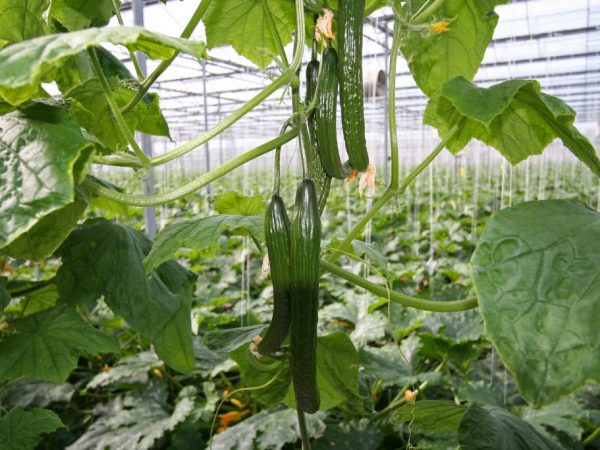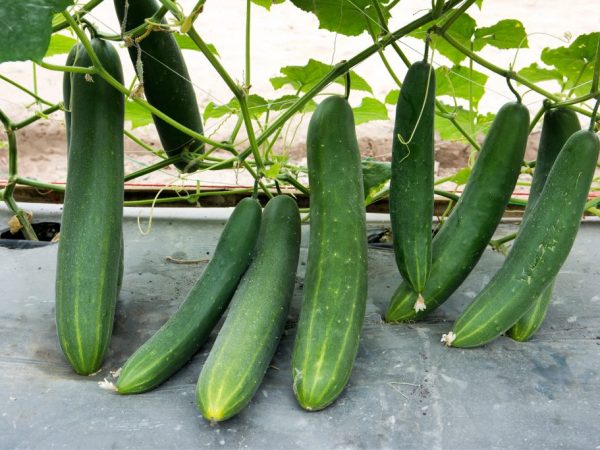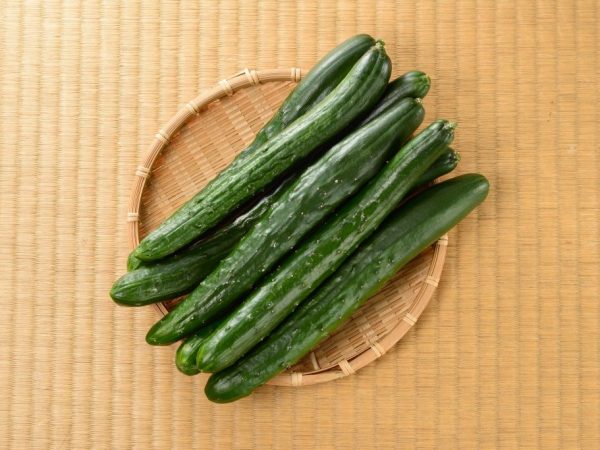Chinese varieties of cucumbers
Chinese varieties of cucumbers have been grown by summer residents in greenhouses not so long ago. Although this vegetable in appearance and taste practically does not differ from the classic cucumber crops we are used to, not every gardener is ready to experiment with this variety.
- Characteristics of Chinese cucumbers
- Cultivation feature
- Advantages and disadvantages
- Dignity
- disadvantages
- Chinese miracle
- The subtleties of cultivation
- White delicacy
- The subtleties of cultivation
- Chinese snake
- The subtleties of cultivation
- Emerald Stream
- The subtleties of cultivation
- Heat-resistant variety
- The subtleties of cultivation
- Alligator
- The subtleties of cultivation
- Other varieties
- The emperor
- Gin
- Momordica
- Cold resistant

Chinese varieties of cucumbers
Characteristics of Chinese cucumbers
Regardless of belonging to any particular variety, all varieties of cucumbers originally from China have a similar characteristic:
- these are vegetables elongated in length, the average size of which is from 35 to 80 cm,
- in taste, it is slightly sweeter than the classic types of cucumber culture, and gives off a fresher smell, somewhat reminiscent of watermelon and melon,
- the peel of a cucumber, unlike our usual, is never bitter,
- the inner cucumber pulp in Chinese varieties is relatively dense, without voids,
- cucumber seeds are centered.
In the vast majority of Chinese varieties of cucumbers, plants have female flowers, collected in bunches.
Cultivation feature
The technology of growing Chinese cucumber is basically not much different from the cultivation of classic cucumber vegetable crops. When cultivating this variety, gardeners note as an additional bonus the opportunity to plant them more densely than can be allowed when planting ordinary cucumber species. This is due to the fact that for a cucumber from China, which grows mainly with the formation of one stem up to 3 m in height, there are almost no lateral shoots. The formed ones are rather short in length.
Advantages and disadvantages
Dignity
The Chinese cucumber has several advantages over the classic cucumber varieties.
- High yield rates. Even in the case of a poor harvest in a summer cottage, up to 30 kg of vegetables can be harvested from one bush. Chinese cucumbers show the best performance when grown in greenhouse conditions, but many gardeners have adapted to growing vegetables in open soil. The good stability of vegetables makes it possible to do this not only in the southern regions, but also in the north.
- Early maturity. The period from the beginning of germination to the moment of the first harvest often covers a little more than 35-45 days.
- Compactness when growing. It is enough to plant 3-4 bushes in the garden to get a decent harvest for the whole family.
- A good help in cultivation is also the resistance of varieties to most diseases characteristic of the cucumber culture, self-pollination of plants, shade tolerance and an attractive presentation.
disadvantages
When cultivating cucumbers bred in China, gardeners noted several disadvantages.
- The most significant disadvantage of summer residents is the poor keeping quality of vegetables. This feature of the cucumber requires the use of the plucked vegetable immediately, otherwise it becomes soft, dried and dehydrated.
- Another disadvantage of Chinese vegetables is considered their suitability exclusively for preparing salads. They are not suitable for pickling and canned preparations.
- Many drawbacks note the poor germination of seed.
- For some gardeners, the obligatory vertical garter of cucumber bushes is also a disadvantage. Without such a technique, when grown, vegetables grow hook-shaped.
Chinese miracle
The type of cucumber The Chinese miracle is classified as late, ripening 2-2.5 months after the appearance of primary shoots, its description includes a set of characteristics inherent in most varieties native to China:
- cucumber 0.4-0.55 m long, slightly curved cylindrical in shape, the surface is covered with small tubercles,
- the taste is sweet, without bitterness.
Cucumbers withstand transportation well and bear fruit, are quite fruitful, almost without barren flowers, show good disease resistance.
The subtleties of cultivation

This variety can easily withstand the cold.
When growing a Chinese miracle, a number of features should be taken into account:
- cultivation is carried out by seedlings, the appropriate time for planting seed is March-April,
- the depth of planting seeds should be no more than 3-4 cm, the planting scheme - every 15-40 cm,
- transplanting cucumber seedlings into the ground is carried out in the second half of May-June.
The unpretentious Chinese miracle does not require a lot of light and easily copes with cold weather. Long shoots require a garter of the bushes, which ensures the correct development of the plant, and in the future it also makes harvesting easier.
White delicacy
Chinese breeders have bred a Chinese cucumber with an atypical almost white color called White Delicacy. In the description of vegetables, only sometimes a weak greenish tint is mentioned. The characteristics of the White delicacy include a number of features:
- mid-ripening variety, ripening in 45-50 days from the moment the initial shoots appear until the date of technical maturity of vegetables,
- The white delicacy is grown equally well in greenhouse conditions and in open soil,
- vegetables of uncharacteristic length for Chinese varieties - only 12-15 cm, conical in shape, with small tubercles on the surface,
- yield indicators are about 4 kg per cucumber bush.
The subtleties of cultivation
The white delicacy, like most Chinese varieties, is grown in seedlings. Sowing of seed material occurs in March, diving occurs after the appearance of 1-2 leaves on the shoots, which are planted in the ground a month after the emerging shoots.
The planting density of the White delicacy is no more than 3 cucumber bushes per square meter of the sown area.
Non-capricious in care White delicacy withstands changes in weather and temperature changes. Among the basic rules for caring for him is regular watering and fertilizing with mineral compounds.
It can be grown without tying, but for a more aesthetic look, it is more expedient to tie the plant to supports.
Chinese snake
The Chinese snake cucumber variety was bred for cultivation in a greenhouse. Its branchy bushes stand out for their intensive development and duration of fruiting. Chinese snake cucumbers grow up to half a meter in length and bend in a light arc as they grow. The skin color is dark green, the surface is covered with a pattern of rare tubercles. Inside the vegetables, the seeds are collected in a small chamber, barely visible.
No different from any other Chinese variety, the Chinese dragon is not bitter and has a sweet taste.
The subtleties of cultivation
Planting the seeds of the Chinese snake is planned one month before the expected date of planting in the soil.A vegetable crop is planted in a greenhouse at the end of May. Seed material is sown to a depth of 2 cm. Among the rules for caring for the variety is the obligatory dive of seedlings. The Chinese snake is more demanding to care for than other species and immediately responds to changes in the watering regime.
The plant shows high yields only on fertile soils with good air permeability, therefore, when grown, sawdust and foliage are often mixed into the soil.
Emerald Stream
Chinese hybrid Emerald Stream refers to a mid-season cucumber culture that ripens from the moment of the first shoots in 45 days. This is a parthenocarpic Chinese cucumber, whose vigorous bushes are weakly woven. The description of the Emerald Stream sets it apart from other Chinese cucumbers. He:
- long-fruited, up to 0.5 m in size,
- parthenocarpic tasty fruits gain weight up to 0.2 kg each,
- the shape of vegetables is cylindrical, the color is dark green, closer to emerald,
- the surface is covered with large bumps.
Due to the weight of vegetables, the yield indicators of the Emerald Stream average 15-18 kg per 1 sq. m of sown area.
The subtleties of cultivation

The fruit can reach 50 cm in length
Sowing of seed material begins no earlier than mid-April, and spacious containers are required for a vigorous variety. Seedlings are transplanted into a greenhouse in the established warm weather. A long fruiting variety often has to be covered so that with the appearance of the first cold weather it does not harm the plant.
When growing the Emerald Stream, they use tying, for which they use trellises and wire.
Heat-resistant variety
The heat-resistant hybrid from China, unlike most, is not self-pollinated, requiring pollination by bees. This early-maturing variety ripens in 2.5-3 months. The plant is formed by one stem with branched bushes.
Chinese cucumbers have a standard cylindrical shape, they are up to 0.3-0.5 m long, their color is green, the surface of the peel is with small tubercles. The heat-resistant variety stands out for its resistance to high temperatures, withstanding 35 ° C.
The subtleties of cultivation
Seed material is planted from April to May. This variety can be grown not only by seedlings, but also by seed. However, when sowing with seeds, you should adhere to a soil temperature of 20 ° C-25 ° C. Otherwise, the seeds of the heat-resistant type of cucumber will not germinate.
Heat-resistant cucumbers can be grown both in a greenhouse and in the open field.
Reviews of gardeners cultivating a heat-resistant variety are advised to plant it on a separate bed, away from other cucumbers in order to avoid mutation of vegetable crops, leading to a decrease in yield. Caring for a vegetable crop is simplified by the small number of stepchildren formed in the plant, but it involves frequent watering. A prerequisite is the creation of a strong support that would support the weight of the tied bushes with vegetables.
Alligator
The early ripe hybrid Alligator pollinated by bees and moths begins to produce the first vegetables 46-48 days after the emergence of shoots. Vegetables have a typical cylindrical appearance, have a length of 0.35-0.4 m, bright green color, with tubercles. The high-yielding Alligator shows a fairly high yield - up to 16-18 kg per 1 sq. m of sown area.
The subtleties of cultivation
This variety, which bears fruit until mid-October, is grown on any soil by the seedling method. Seed material is planted in the first half of April. A month after the moment of planting the seeds, the seedlings are transplanted. It is better to plan the time of growing seedlings so that the bushes are transplanted into the ground at the end of May or in June.
If you want to get an early harvest from the Alligator, the seedlings are transplanted, after warming the soil. This is done 10 days before the transplant by covering the soil with a black film. Only after warming up the soil, the seedlings are planted.
Other varieties
Among the lesser known varieties, there are specific features that stand out from the general mass.
The emperor
Bred in the homeland of Bruce Lee, the Emperor-f1 is a hybrid with an early ripening, which differs from other varieties in a large mass of fruits, reaching a weight of 0.35-0.4 kg. Vegetables grow 5-5.5 cm in diameter. It can be grown in greenhouses and in an open area. You can get the first harvest from the Imperator f1 variety already 45 days after the first shoots.
Gin
Chinese gin is in demand among a number of gardeners, because it is characterized by resistance to fungi. In length, dense vegetables of the f1 hybrid grow up to 0.3-0.4 m and are suitable for fresh salads and canning. It can be grown by seedling and sowing.
Momordica
A vegetable crop with the strange name Momordica, or Indian cucumber, is actually an exotic liana from the pumpkin family, which some exotic lovers began to grow in their greenhouses. Its fruits are yellow in color, outwardly similar to a spindle about 20 cm long, their pimpled surface resembles the skin of a crocodile. It tastes like bitter gourd.
Cold resistant
The climbing hybrid Cold-resistant F1, developed by domestic breeders of the Sedek firm specifically for Russian climatic conditions, belongs to the mid-ripening and yields in 50-55 days. Fruits curved in shape with large tubercles grow up to 0.3-0.5 m in length, have a short neck and a bright green peel.


